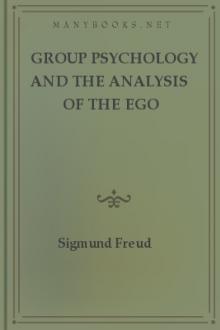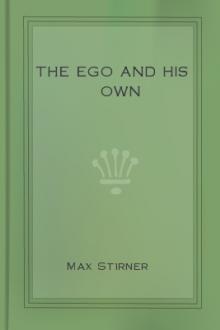Group Psychology and The Analysis of The Ego by Sigmund Freud (top 5 ebook reader .TXT) 📕

- Author: Sigmund Freud
- Performer: -
Book online «Group Psychology and The Analysis of The Ego by Sigmund Freud (top 5 ebook reader .TXT) 📕». Author Sigmund Freud
[34] 'A company of porcupines crowded themselves very close together one cold winter's day so as to profit by one another's warmth and so save themselves from being frozen to death. But soon they felt one another's quills, which induced them to separate again. And now, when the need for warmth brought them nearer together again, the second evil arose once more. So that they were driven backwards and forwards from one trouble to the other, until they had discovered a mean distance at which they could most tolerably exist.' (Parerga und Paralipomena, II. Teil, XXXI., 'Gleichnisse und Parabeln'.)
[35] Perhaps with the solitary exception of the relation of a mother to her son, which is based upon narcissism, is not disturbed by subsequent rivalry, and is reinforced by a rudimentary attempt at sexual object-choice.
[36] In a recently published study, Jenseits des Lustprinzips (1920) [Beyond the Pleasure Principle, International Psycho-Analytical Library, No. 4], I have attempted to connect the polarity of love and hatred with a hypothetical opposition between instincts of life and death, and to establish the sexual instincts as the purest examples of the former, the instincts of life.
[37] See 'Zur Einführung des Narzissmus', 1914. Kleine Schriften zur Neurosenlehre, Vierte Folge, 1918.
[38] [Literally, 'leaning-up-against type'; from the Greek 'ἁνακλἱνω' 'I lean up against'. In the first phase of their development the sexual instincts have no independent means of finding satisfaction; they do so by propping themselves upon or 'leaning up against' the self-preservative instincts. The individual's first choice of a sexual object is said to be of the 'anaclitic type' when it follows this path; that is, when he choses as his first sexual object the same person who has satisfied his early non-sexual needs. For a full discussion of the anaclitic and narcissistic types of object-choice compare 'Zur Einführung des Narzissmus.—Translator.]
[39] See Drei Abhandlungen zur Sexualtheorie, and Abraham's 'Untersuchungen über die früheste prägenitale Entwicklungsstufe der Libido', Internationale Zeitschrift für Psychoanalyse, 1916, Bd, IV; also included in his Klinische Beiträge zur Psychoanalyse (Internationale psychoanalytische Bibliothek. Nr. 10, 1921).
[40] [Kleine Schriften zur Neurosenlehre. Zweite Folge.]
[41] Marcuszewicz: 'Beitrag zum autistischen Denken bei Kindern.' Internationale Zeitschrift für Psychoanalyse, 1920, Bd. VI.
[42] ['Trauer und Melancholie.' Kleine Schriften zur Neurosenlehre, Vierte Folge, 1918.]
[43] ['Instanz'—like 'instance' in the phrase 'court of first instance'—was originally a legal term. It is now used in the sense of one of a hierarchy of authorities or functions.—Translator.]
[44] 'Zur Einführung des Narzissmus', 'Trauer und Melancholie.'
[45] 'Zur Einführung des Narzissmus.'
[46] We are very well aware that we have not exhausted the nature of identification with these samples taken from pathology, and that we have consequently left part of the riddle of group formations untouched. A far more fundamental and comprehensive psychological analysis would have to intervene at this point. A path leads from identification by way of imitation to empathy, that is, to the comprehension of the mechanism by means of which we are enabled to take up any attitude at all towards another mental life. Moreover there is still much to be explained in the manifestations of existing identifications. These result among other things in a person limiting his aggressiveness towards those with whom he has identified himself, and in his sparing them and giving them help. The study of such identifications, like those, for instance, which lie at the root of clan feeling, led Robertson Smith to the surprising result that they rest upon the recognition of a common substance (Kinship and Marriage, 1885), and may even therefore be brought about by a meal eaten in common. This feature makes it possible to connect this kind of identification with the early history of the human family which I constructed in Totem und Tabu.
[47] Cf. Drei Abhandlungen zur Sexualtheorie, l.c.
[48] 'Über die allgemeinste Erniedrigung des Liebeslebens.' Kleine Schriften zur Neurosenlehre, Vierte Folge, 1918.
[49] Cf. 'Metapsychologische Ergänzung zur Traumlehre.' Kleine Schriften zur Neurosenlehre, Vierte Folge, 1918.
[50] W. Trotter: Instincts of the Herd in Peace and War. Fisher Unwin, 1916.
[51] See my essay Jenseits des Lustprinzips.
[52] See the remarks upon Dread in Vorlesungen zur Einführung in die Psychoanalyse. XXV.
[53] Totem und Tabu.
[54] What we have just described in our general characterisation of mankind must apply especially to the primal horde. The will of the individual was too weak; he did not venture upon action. No impulses whatever came into play except collective ones; there was only a common will, there were no single ones. An idea did not dare to turn itself into a volition unless it felt itself reinforced by a perception of its general diffusion. This weakness of the idea is to be explained by the strength of the emotional tie which is shared by all the members of the horde; but the similarity in the circumstances of their life and the absence of any private property assist in determining the uniformity of their individual mental acts. As we may observe with children and soldiers, common activity is not excluded even in the excremental functions. The one great exception is provided by the sexual act, in which a third person is at the best superfluous and in the extreme case is condemned to a state of painful expectancy. As to the reaction of the sexual need (for genital gratification) towards gregariousness, see below.
[55] It may perhaps also be assumed that the sons, when they were driven out and separated from their father, advanced from identification with one another to homosexual object love, and in this way won freedom to kill their father.
[56] 'Das Unheimliche.' Imago, 1919, Bd. V.
[57] See Totem und Tabu and the sources there quoted.
[58] This situation, in which the subject's attitude is unconsciously directed towards the hypnotist, while he is consciously occupied with the monotonous and uninteresting perceptions, finds a parallel among the events of psycho-analytic treatment, which deserves to be mentioned here. At least once in the course of every analysis a moment comes when the patient obstinately maintains that just now positively nothing whatever occurs to his mind. His free associations come to a stop and the usual incentives for putting them in motion fail in their effect. As a result of pressure the patient is at last induced to admit that he is thinking of the view from the consulting-room window, of the wall-paper that he sees before him, or of the gas-lamp hanging from the ceiling. Then one knows at once that he has gone off into the transference and that he is engaged upon what are still unconscious thoughts relating to the physician; and one sees the stoppage in the patient's associations disappear, as soon as he has been given this explanation.
[59] Ferenczi: 'Introjektion und Übertragung.' Jahrbuch der Psychoanalyse, 1909, Bd. I [Contributions to Psycho-Analysis. Boston, Badger, 1916, Chapter II.]
[60] It seems to me worth emphasizing the fact that the discussions in this section have induced us to give up Bernheim's conception of hypnosis and go back to the naïf earlier one. According to Bernheim all hypnotic phenomena are to be traced to the factor of suggestion, which is not itself capable of further explanation. We have come to the conclusion that suggestion is a partial manifestation of the state of hypnosis, and that hypnosis is solidly founded upon a predisposition which has survived in the unconscious from the early history of the human family.
[61] 'Trauer und Melancholie.'
[62] Totem und Tabu.
[63] Trotter traces repression back to the herd instinct. It is a translation of this into another form of expression rather than a contradiction when I say in my 'Einführung des Narzissmus' that on the part of the ego the construction of an ideal is the condition of repression.
[64] Cf. Abraham: 'Ansätze zur psychoanalytischen Erforschung und Behandlung des manisch-depressiven Irreseins', 1912, in Klinische Beiträge zur Psychoanalyse, 1921.
[65] To speak more accurately, they conceal themselves behind the reproaches directed towards the person's own ego, and lend them the fixity, tenacity, and imperativeness which characterize the self-reproaches of a melancholiac.
[66] [Literally: 'How he clears his throat and how he spits, that you have cleverly copied from him.']
[67] What follows at this point was written under the influence of an exchange of ideas with Otto Rank.
[68] Cf. Hanns Sachs: 'Gemeinsame Tagträume', a summary made by the lecturer himself of a paper read at the Sixth Psycho-analytical Congress, held at the Hague in 1920. Internationale Zeitschrift für Psychoanalyse, 1920, Bd. VI. ['Day-Dreams in Common'. International Journal of Psycho-Analysis, 1920, Vol. I.]
[69] In this brief exposition I have made no attempt to bring forward any of the material existing in legends, myths, fairy tales, the history of manners, etc., in support of the construction.
[70] Cf. Drei Abhandlungen zur Sexualtheorie.
[71] Hostile feelings, which are a little more complicated in their construction, offer no exception to this rule.
[72] [Schriften zur angewandten Seelenkunde. Heft 8. Vienna, Deuticke, 1910.]
[73] See 'Über die allgemeinste Erniedrigung des Liebeslebens.'
[74] See Totem und Tabu, towards the end of Part II, 'Das Tabu und die Ambivalenz'.
[75] See Drei Abhandlungen zur Sexualtheorie, 4. Auflage, 1920, S. 96.
End of the Project Gutenberg EBook of Group Psychology and The Analysis of
The Ego, by Sigmund Freud
*** END OF THIS PROJECT GUTENBERG EBOOK GROUP PSYCHOLOGY ***
***** This file should be named 35877-h.htm or 35877-h.zip *****
This and all associated files of various formats will be found in:
http://www.gutenberg.org/3/5/8/7/35877/
Produced by Chuck Greif, University of Michigan and the
Online Distributed Proofreading Team at http://www.pgdp.net
Updated editions will replace the previous one--the old editions
will be renamed.
Creating the works from public domain print editions means that no
one owns a United States copyright in these works, so the Foundation
(and you!) can copy and distribute it in the United States without
permission and without paying copyright royalties. Special rules,
set forth in the General Terms of Use part of this license, apply to
copying and distributing Project Gutenberg-tm electronic works to
protect the PROJECT GUTENBERG-tm concept and trademark. Project
Gutenberg is a registered trademark, and may not be used if you
charge for the eBooks, unless you receive specific permission. If you
do not charge anything for copies of this eBook, complying with the
rules is very easy. You may use this eBook for nearly any purpose
such as creation of derivative works, reports, performances and
research. They may be modified and printed and given away--you may do
practically ANYTHING with public domain eBooks. Redistribution is
subject to the trademark license, especially commercial
redistribution.
*** START: FULL LICENSE ***
THE FULL PROJECT GUTENBERG LICENSE
PLEASE READ THIS BEFORE YOU DISTRIBUTE OR USE THIS WORK
To protect the Project Gutenberg-tm mission of promoting the free
distribution of electronic works, by using or distributing this work
(or any





Comments (0)